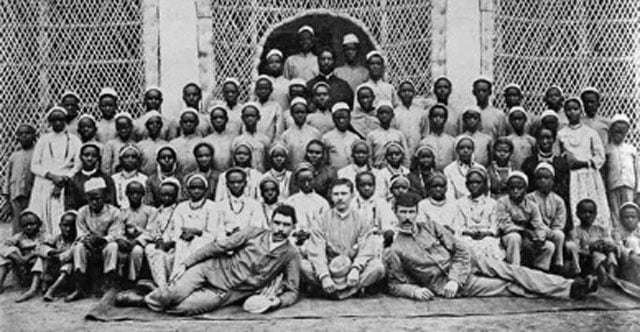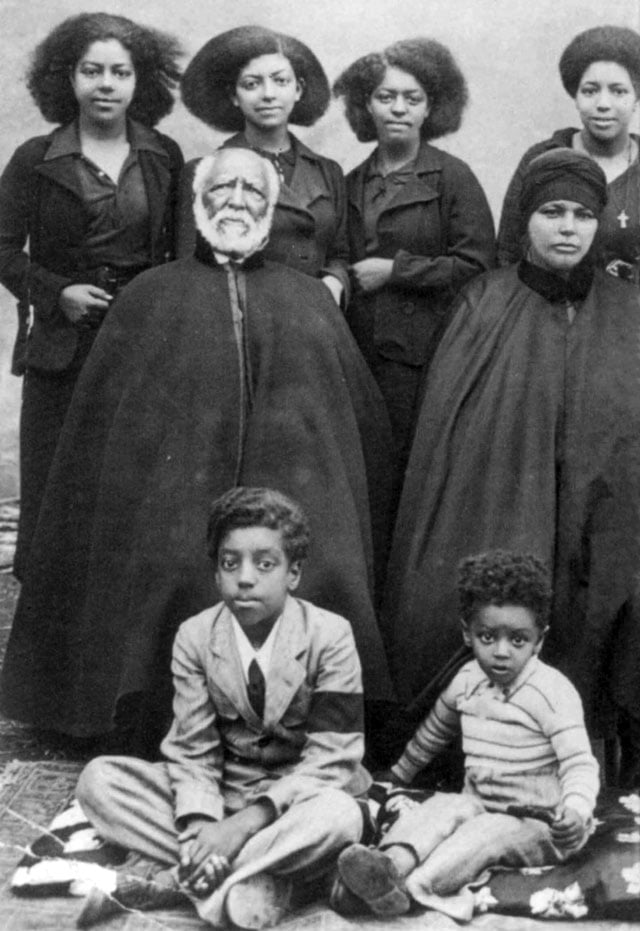Life and ministry
Gebru Desta [ገብሩ ደስታ, alias Gäbrä Ǝgziʾabəḥer Dästa and Gobaw] was born in Takusa (near Gondar) around 1856. He grew up in Dembiya. At Emperor Tewodros’ crafts and arms workshop in Gafat he was introduced to St. Chrischona missionaries Theophilus Waldmeier and Johannes Maier (alias Mayer), from whom he received his first education.
After Emperor Tewodros’ defeat at Amba Mariam (alias Maqdala), Gobaw Desta and seven other teenagers were taken to Jerusalem and enrolled in two missionary schools. In 1872, Gobaw moved towards Basel (and most likely attended an [orphan] school in Germany). From 1873 to the summer of 1877, he studied at the Pilgrim Mission’s Training Institute in St. Chrischona. Then he moved to Korntal and worked with Krapf on the revision of the Amharic New Testament for some months.
Gobaw Desta arrived in Ethiopia in February 1878 and was assigned to teach at a school for Beta Israel (formerly called ‘Falasha’) in Azezo. As Tekle Haymanot of Gojjam was looking for a teacher trained in Europe, mission representative Flad released Gobaw to run a school in Gudru in early 1881.
- Bahru Zewde, Pioneers, p. 44: Tekle Haymanot put him in charge of the Ginde Beret district, which he “converted into an evangelical base”.
- Bauerochse, Oromoland, p. 106, calls him “the first Protestant missionary to the Oromos”. Note that kantiba Gebru Desta also contributed to the mission among the Oromos by making his property in Aira available to the German Hermannsburg Mission.
In 1882, Negus Menilek defeated Tekle Haymanot at the Battle of Embabo. Gobaw moved on and taught at Johannes Maier’s school for the Oromo in Balli (a small village in East Shewa Zone). When Emperor Yohannes banned missionary work in Ethiopia in 1886, Gobaw traveled to Jerusalem and taught at Schneller’s Orphanage.
Beginning in December 1887, Gobaw served with the new Evangelische Missionsgesellschaft für Deutsch-Ostafrika in Dar es Salaam for about one year. When the local people revolted against Carl Peters‘s colonising society, the mission house was also destroyed and Gobaw fled to Aden. There, he met a group of about 40 children (mainly Oromo) recently captured from slave-traders. Gobaw taught the young people in a nearby school run by the Keith Falconer Mission until they were taken to South Africa in the summer of 1890.
Afterwards, Gobaw was engaged by the British and Foreign Bible Society to travel from Yemen to the Harar area and work as a Bible colporteur.
A few years later, the Governor of Harar (Makonnen Wolde Mika’el) appointed him chief of the city’s police force.
- By this time, Gobaw had his calling name changed [back?] to Gebru—a short form of Gäbrä Ǝgziʾabəḥer—and approached the Ethiopian Orthodox Tewahedo Church.
After the Battle of Adwa in 1896, Gebru became mayor (kantiba) of Gondar. One of his main focuses was to strengthen education.
Due to his language skills, Gebru later served as an intermediary in the government’s relations with foreigners and as an adviser. His official travels took him to the Sudanese Mahdist State (1897), England (1901, 1910) and the USA (1919, 1930).
During the Italian occupation, Käntiba Gebru Desta was a member of the Black Lions resistance movement. He and his surviving family members were imprisoned on Italian territory until 1941. After his return to Ethiopia, he was a member of the Senate. Gebru Desta passed away in 1950 and was burried in the Addis Ababa district of Gullale.
Gebru Desta was married several times. Some of his children rendered outstanding services to Ethiopia:
- Senedu Gebru (1916-2009) was an educator, politician and supporter of women.
- Emahoy Tsege-Mariam Gebru (née Yewubdar Gebru, 1923-2023) was a musician and nun.
- Three of Gebru’s older sons joined the Black Lions resistance movement and were killed by the Italian invaders.
- Colonel Dawit Gebru was a famous police officer and wrote his father’s biography.
Pictures

(Gebru Desta: centre back; William Gardner: centre front).
Adapted from fig. 8.7 in Shell, Children of Hope.

adapted from Bahru Zewde, Pioneers of Change, p. xiv.
* Addis Ababa, Institute of Ethiopian Studies
Video
Further reading
» Bibliography with links
» Gobau Desta, Curriculum vitae for application to the St. Chrischona Institute
» Gebru Desta, Selected letters with English translation
» Gebru Desta teaching Oromo children in Yemen (1889-90)
» Gebru Desta in the USA (1919)